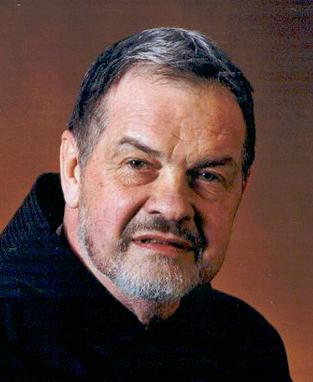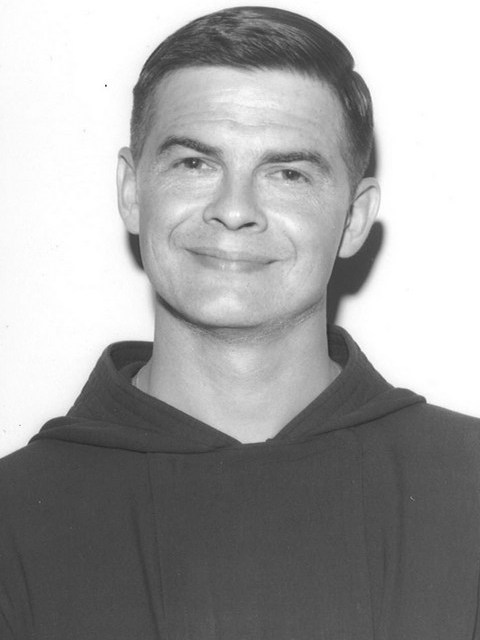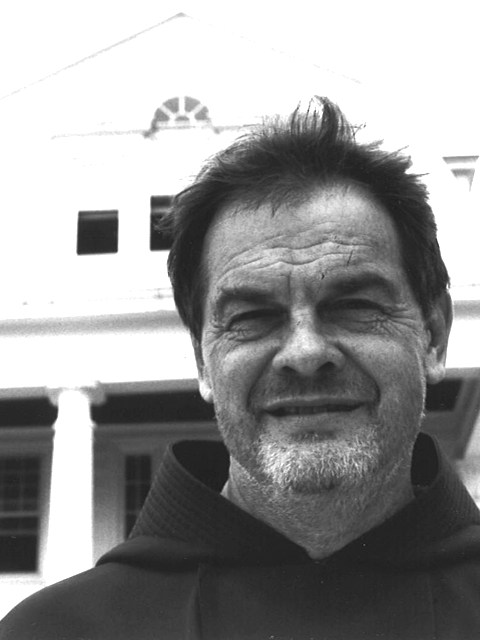 Date of birth: January 5, 1928
Date of birth: January 5, 1928
Place of Birth: Davis, WV
Investiture: August 1, 1961*
Dispensed of Perpetual Vows: October, 1970
Temporary Profession: October 14, 1990*
Perpetual Profession: August 21, 1993
Date of death: October 25, 2013
Burial: St. Augustine Cemetery
Millvale, PA
"I didn't feel free to tell anyone
what was going on inside.
They might think I was crazy or something."
No friar has become a Capuchin friar of the Province of St. Augustine so many times in his lifetime. Jim Allman did it three times -- that the third time was a 'charm' is no surprise.
In a revealing journal on the life of our brother Jim, Fr. Lester Knoll, OFM Cap., has compiled a remarkable array of events and Jim's own reflections that divulge the 'insides' of a man who seldom spoke about himself at all. In The Quest for a Niche: The Spiritual Journey of Br. James Allman, OFM Cap., Fr. Lester captures snapshots along the path of a fascinating faith journey. Few would use 'fascinating' to describe him, but the 'still waters' we encountered in this 'unassuming' and 'introverted' man ran deep indeed.
He was born as the only child to coalminer Clarence and Wilda Allman on January 5, 1928, in Davis, WV. He recounts that they practiced no religion. His baptism took place by chance: the family was present at the house of friends when a Presbyterian minister arrived to baptize their child. Jim's parents accepted the offer to have their own baby baptized as well. Are we all that surprised that his 'spiritual rebirth' took place just by his 'being there'? He spent his childhood without practicing any faith whatsoever, and he characterized himself as an 'agnostic' by the time he graduated from Davis High School in 1946.
As he matured, Jim wanted to be a helper; his sensitive heart would lead him to care-giving again and again. He attended the University of West Virginia with thoughts of medical school, majoring in psychology, but there wasn't enough money to complete the program. Drafted into the army in 1949, he was sent to Germany. It was on a vacation in Switzerland with some companions that he encountered his first religious experience at the Shrine of the Black Madonna of Einselden. The experience was not a comforting one. He felt as though he didn't 'belong there.' He did not believe in God, and the nausea and chest pain he suffered would not allow him to approach the shrine's altar.
A diagnosis of tuberculosis in April 1952 would provide him a more profound encounter. He was assigned to Valley Forge Army Hospital in Phoenixville, PA, where he would remain until October of 1954, 18 months beyond his army discharge. Quarantined with other afflicted veterans, he was moved by a soldier who had lost an eye and leg from a land mine and now was facing a divorce. On Christmas Eve, the depressed man asked the others to pray for him and his wife, but Jim would make his own that prayer of desire to be at peace: "God, if you do exist, please let me believe." It was the beginning of a new life. He sought out the Catholic chaplain and was conditionally re-baptized and received first Communion in April, 1953.
Reading and praying became an obsession for the young man, though few knew what was going on inside. He came to know of Padre Pio and felt that if this man was so holy, his Order must be blessed as well. While living in Trenton, NJ, his Franciscan attraction led him to attend Mass at a Franciscan parish there (Jim describes it being 'run by Polish Franciscans' €“ but they were Hungarian). The pastor, Fr. Julian Füzer, OFM, was to write his letter of recommendation for Jim's first entrance to the Capuchin life:
I personally know James Allman and can write to you the very best of him. He is a pious young man, who attends Mass and receives Holy Communion daily and goes to Confession every week. He is a convert and it seems that his turning was a special work of divine grace. Recently he joined the Third Order of St. Francis.
I think that he is a real vocation, and I am confident that he will be a real credit to the Order. God willing, you will get a very good Brother in him. (June 29, 1955)
 Jim was accepted as a Capuchin postulant in 1955 and began his formation at the Lay Brothers Training Center in Cumberland, MD, before making his novitiate at St. Conrad Friary in Annapolis, MD, taking the name of 'Br. Urban.' He made temporary profession as a Capuchin friar on August 22, 1957, and returned to Cumberland, years which he would describe as 'heaven and hell.'
Jim was accepted as a Capuchin postulant in 1955 and began his formation at the Lay Brothers Training Center in Cumberland, MD, before making his novitiate at St. Conrad Friary in Annapolis, MD, taking the name of 'Br. Urban.' He made temporary profession as a Capuchin friar on August 22, 1957, and returned to Cumberland, years which he would describe as 'heaven and hell.'
[I tried] to live in two worlds (the interior and the exterior) at the same time. I felt I could not deny the reality of a Divine presence within my being, and felt drawn toward more prayer, but did not feel free to talk to anyone about this inner world.
For me, I did not feel there was adequate time for prayer; I was kept busy with tasks. It was during this period that I learned about more contemplative Orders in the Church. I felt that perhaps that type of life would be best for me; I did not see the possibility of being more contemplative with the Capuchins. (Quest, p. 3)
His first departure came in 1960 and plunged him into what he regarded as a 'Dark Night.' A Carthusian confessor told him that he should return to the Capuchins, and Jim requested re-admission in 1961. Fr. Giles Staab, OFM Cap., Provincial Minister, appealed to Rome for his second entrance: "After having spoken with Brother Urban, I am convinced that he should be given the opportunity to return. Father, would you please petition the Holy See for a rescript permitting the re-admission of this young man to our novitiate?"
Few friars find it easy to endure one novitiate. Jim had two. It was there he tried to express himself to Fr. Peter Hohman, OFM Cap., his Novice Director a second time, about his desire to live a life of more fervent prayer, sharing the extraordinary experiences of union he was witnessing:
I tried to speak with him about my conflicts. He told me that what I was talking about was only for "chosen souls". Well, I knew that was not me! But I couldn't deny my experiences. My reasoning went like this: 'The experiences I have had were very real and I am unable to deny them.' But Fr. Peter said such experiences are only for chosen souls. But I am just an ordinary guy, so I can't be a chosen soul. I concluded that these kinds of experiences were common, ordinary, and people just didn't talk about them.
'Urban' professed temporary vows in 1962, and he requested perpetual profession three years later, recommended unanimously by his fraternity in Herman, PA, where he had served as tailor and infirmarian at St. Fidelis Seminary. Despite the confusion and doubts which continued to plague him, he felt that the 'right place' for him was among the friars.
His father died in 1969, and only-child Jim sought time to care for his mother. In November, he was granted a leave of absence for six months. It became obvious to him that his obligations as a son kept him from returning to fraternal life; Thomas More Janeck, OFM Cap., Provincial Minister , received Rome's dispensation from Solemn Vows in October, 1970, and "Urban of Davis" became "James Allman" a second time.
Jim cared for his mother in Lincoln Park, MI, until her death in February, 1986. He had the opportunity to earn his Bachelor Degree in Art (with a minor in psychology), in 1973 from Wayne State University and to begin graduate school there. "I worked at my studies and did housekeeping at a nearby Veterans Hospital" he was to say, "but the ache, the silence and the agony continued."
The month following his mother's passing, he was invited to live among the Camaldolese at Holy Family Hermitage in Bloomingdale, OH. Was this the contemplative life for which he yearned? He gave all of his belongings away to relatives, left his apartment and quit his job. He sensed that he was 'getting older,' and at 58, he 'wasn't getting any younger.' Who would accept him to Religious Life now? He would later see this impulse for a quick resolution had not brought him to the 'right place.' He stayed for one month among them.
Jim made contact with then Provincial Minister Francis Fugini, OFM Cap. He applied and was accepted to postulancy in Washington, DC, arriving on the feast of St. Francis, October 4, 1986. His ministry brought him among AIDS/HIV patients with the Missionaries of Charity, but the hectic pace of a study house and the disquiet of younger friars in discernment was unsettling for him: it was not the Order he had left years before. Within six months, Jim left the friars for the third time. He returned to the Camaldolese of Bloomingdale and was invested as a novice there on Francis' feast day in 1987, but he describes his life as a 'non-descript gray.' After some powerful prayer experiences, he was surprised by a visit of our brother Bill Wiethorn, OFM Cap. "I felt as though I was rejoining a family," he said. The visit moved him to tears, and he came to realize that the life of the Camaldolese, with its regulated Benedictine routine, was disturbing. He departed the life of the monks at Easter of 1988.
I was again back on the road, a pilgrim searching for a niche in life. Over the years I was becoming more and more sure that this inner 'knowing' or 'being led' was genuine and that I had to follow it, even if I am unable to explain it to anyone and even if I am unable to find another person who seems to be able to comprehend what I am talking about. It's like feeling that you knew that this reality is true. It is certainly true for me. I believed that it was true. However, there was always the possibility that I might be wrong; I could be deluded. I was living over a long period of my life with apparently two contradictory parts of life, with both being true, and yet not knowing how to put the two together."
In December, he was accepted as a postulant in the Trappist monastery in Louisville, KY, but lasted there only 4 months, departing after Easter of 1989. He came knocking on the doors of our Provincial house and was received again by Fr. Francis. This time, an agreement was made allowing Jim the freedom to live, work and pray among the friars with no pressure to decide about vows.
 His fourth and final request to become a friar came in the summer of 1990, when he was allowed (by virtue of the Code of Canon Law of 1983) to renew his vows without making a third novitiate year. Living at St. Conrad Friary in Allison Park, PA (the Province's novitiate), he was able to find the privacy for prayer and an outlet for his charity and service at St. Joseph Home in Pittsburgh, PA. He made his perpetual profession for the second time in August 21, 1993 at the age of 65. These were, finally, his 'final vows.'
His fourth and final request to become a friar came in the summer of 1990, when he was allowed (by virtue of the Code of Canon Law of 1983) to renew his vows without making a third novitiate year. Living at St. Conrad Friary in Allison Park, PA (the Province's novitiate), he was able to find the privacy for prayer and an outlet for his charity and service at St. Joseph Home in Pittsburgh, PA. He made his perpetual profession for the second time in August 21, 1993 at the age of 65. These were, finally, his 'final vows.'
The assignments in the last 20 years of his journey were sensitively respectful of the man who searched for calm and quiet, for time to pray. His discomfort in chatting and fraternal recreation reflected that unquenchable thirst for inner peace more than any rejection of the brothers who surrounded him. He would try his best in the intervening years to avoid provincial assemblies or celebrations (except for funerals), but an irony that remained is that few friars ever believed that he was avoiding them. Jim was respected for his goodness and kind heart, and friars who knew him never pressured him to be more than what he was, a contemplative soul. Thirsty for continual union with the Lord, he was plagued with restlessness in the face of everyday conflicts whose issues seemed to matter so much less than his interior life.
After the initial experience of Divine intimacy, it was impossible to lay it aside as though it didn't happen. I did nothing special. I didn't climb the highest mountain or swim the ocean to claim this prize. It is just given to me, sheer grace! (Quest, 25)
He was stationed for seven years (1993-2000) in Cleveland, OH, at St. Paul Friary where he was able to mingle his spirit in the contemplative environment provided by the presence of the Poor Clares of Perpetual Adoration. His work in service to the Hunger Center was an anchor and his fraternal life was less demanding among friars who cherished his presence and understood his need for a serene environment.
Twice he was granted his requests to be a part of the Hermitage community in Wheeling, WV (2001-2004, 2010-2011), interrupted by both a short stay with the Postulancy community in Philadelphia (2004-2005) and an invaluable presence for service to the senior friars of St. Augustine Friary in Pittsburgh (2005-2010). It was only his declining health which forced him to leave the Hermitage a second time and return to St. Augustine's in 2011. He lived out his final two years with difficulty in walking and chronic fatigue. As his system began to fail, he spent his final months in hospice care at Canterbury Place, a skilled care facility of UPMC near the motherhouse. He experienced his Transitus to final union with the Lord on October 25, 2013, at the age of 85.
Fr. David Nestler, OFM Cap., Provincial Minister, celebrated the Mass of Christian Burial on October 29, 2013, and Br. Jim's spiritual companion, Fr. Lester, offered the homily. Lester noted that when Jim first wrote down his funeral wishes, he requested that the prologue to the Gospel of John be read, followed by five minutes of silence. Jim had envision there to be no homily -- fearful, perhaps, that someone might talk about him and give him more attention than he ever allowed in his lifetime. Fortunately, in the end, he left the funeral arrangements in the hands of the Provincial, and Lester was asked to unpack the Gospel Jim's life attempted to make flesh.
Fr. Lester wove the images of Jim as a true 'mystic' with that of being a 'prayer warrior' whose union with the Lord was a true mission of penance and service. Jim had consecrated himself to be 'victim,' whose inner sufferings and struggles, his turbulence and doubts, provided a fertile ground for God's abundant grace and goodness which permeated his spirit. John's Gospel got its mention: "The Word became flesh, and made its dwelling among us" (John 1:14).
Some say that an only child finds comfort in sorting out things alone. For a man whose silence would protect being misunderstood or judged, he would never really know how precious he was to the brotherhood. Crazy or not, Jim was a true and authentically fraternal gift. As that first Franciscan pastor, Fr. Julian, had foretold in 1955's letter of recommendation, we indeed "[got] a very good Brother in him."
